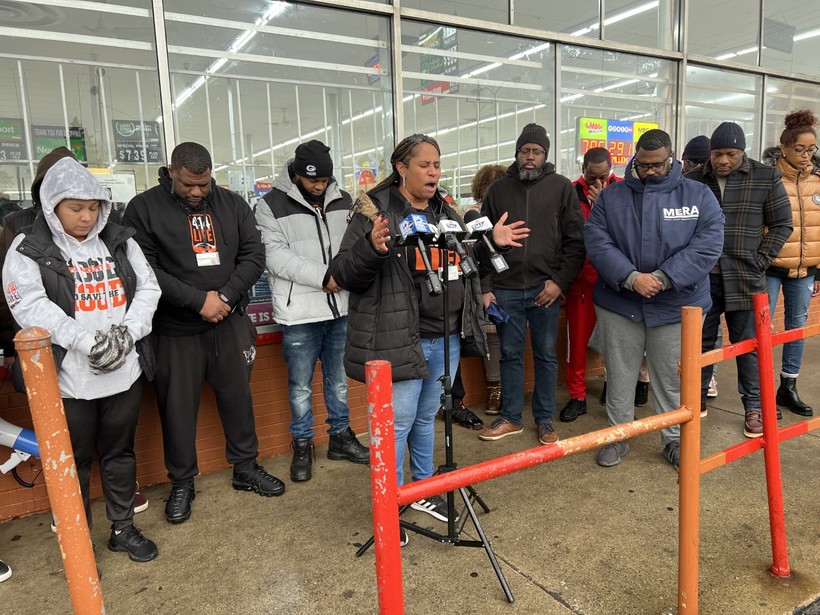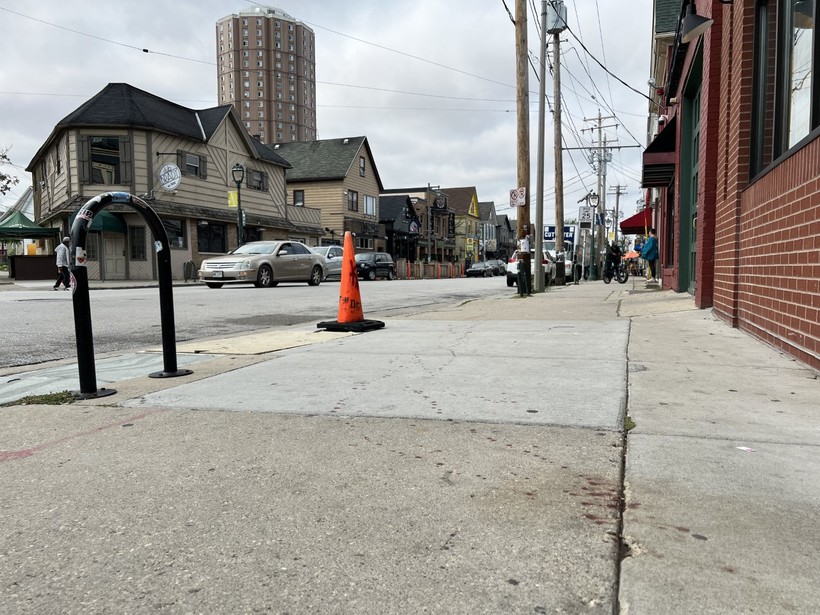Milwaukee Leaders Decry Homicides, Call For Change
City had 214 murders in 2022, up from 193. 'We need it to stop today.'

Community organizers in Milwaukee pray for peace following a violent 2022 on Jan. 3, 2023. Evan Casey / WPR
Standing in the rain, just feet from the site of a deadly shooting that occurred two days prior, community activists gathered to collectively pray for one thing in the new year — peace.
“We’re coming to stand together today to say that it (violence) must stop. It must stop,” Shanel Vrontez, the community engagement coordinator for 414Life, told the gathering last week. “We don’t even want to get anywhere near where we were last year, or 2021 or 2020. We need it to stop today.”
Homicides in the city have more than doubled since 2019. According to data from the Wisconsin Department of Justice, there were 97 homicides in Milwaukee just four years ago. In 2022, the Milwaukee Police Department investigated 214 homicides — a 120 percent increase over three years. It’s possible that figure could increase or decrease in the coming weeks and months as investigations and autopsies are completed.
It was a grim year for gun violence in the state’s largest city, as several high profile murders and mass shootings left local leaders grasping for answers.
“When individuals are killed in the community, it doesn’t just affect them, it affects everybody that’s around them,” said Milwaukee Mayor Cavalier Johnson. “It’s this ripple effect that happens across the community.”
Milwaukee is not alone in dealing with a spike in violent deaths. The homicide rate across the nation increased 30 percent between 2019 and 2020, according to a report from the Pew Research Center. But Milwaukee’s 95 percent increase during that time period dwarfs that spike. According to a national study, the city also had the fifth-highest homicide rate increase in the country since 2020.
Law enforcement experts have pointed to the impact of the COVID-19 pandemic and the increasing number of guns on the street as possible reasons for the spike. But local leaders are searching for ways to ensure Milwaukee doesn’t achieve another record in 2023.
“We have to come together, we have to band together and do everything we can in our power to change that, to speak to our community,” said Deshawn Ewing of Milwaukee’s Office of Violence Prevention.

Blood droplets can be seen on Brady Street following a shooting that left four injured on Wednesday, Sept. 14, 2022. Evan Casey / WPR
Leaders want to see more action on the issue
Tracey Dent, a community activist with Peace for Change Alliance, said he’s tired of discussing the issue year after year, after he attended a citywide vigil for 2022 homicide victims in December.
“We do a lot of talking, like we’re going to do this, we’re going to do that, but actually, it has very little impact when it comes against violence,” Dent said, adding that he wants to see more collaboration from community groups to decrease the number.
“When this pandemic started, we lost access to a lot of those young people that we were consistent with,” Mayes said. “That’s unacceptable. That’s a failure on our end and that’s a failure in the process.”
In 2017, Milwaukee passed the comprehensive plan “Blueprint for Peace,” which focuses on ending gun violence, providing more economic opportunity and expanding counseling for traumatized children. Homicides declined in Milwaukee from 2017 to 2019 following its implementation, but the three-year increase in deaths is prompting officials to take another look at the plan.
Leaders also said residents need to be part of the solution. Ewing, of Milwaukee’s Office of Violence Prevention, urged the community to speak up if they see something and to talk to family and friends about the impact of gun violence.
“Speak to them, hold them accountable,” Ewing said. “I know you don’t want your baby boy, your grandson, your grandchild locked up. But let’s get them the support they need, get them the services they need so that they can be the ones to help make this change in our community as well.”
Activists say policing isn’t the only answer
The Milwaukee Police Department is down over 200 officers since 2018. The city recently received a $16 million federal grant to hire 50 more police officers over a three-year period.
But Johnson said he believes more funding for public safety isn’t the only answer when it comes to gun violence.
Ewing echoed that sentiment, but he added that he wants to see more funding for local groups and organizations dedicated to violence prevention and mental health work.
“I believe we’ve overwhelmingly placed disparities in our communities by forcing police to handle all issues and problems, and taking monies away from organizations and community groups and partners that can deal with mental health,” Ewing said.
Dent said he believes the city should take a collaborative approach with police and community groups. Part of that approach can include attending public listening sessions with the police and elected officials. In 2022, the Milwaukee Police Department held monthly listening sessions to get community feedback on how to address public safety.
“We have to have more funding for the police but also for mental health and programs like that,” Dent said.
A public health approach
414Life, which focuses on educating the community about the harms of gun violence, helped organize the community event.
Lynn Lewis, director of 414Life, said the group works with Milwaukee’s Office of Violence Prevention in taking a public health approach to ending gun violence. Some experts believe that approach can help address the root causes of violence.
The Office of Violence Prevention defines a public health approach as:
- “Defining the nature and scope of the violence problem through data collection
- Researching why violence occurs, who it affects, risk and protective factors, and other influences that can be impacted through intervention strategies
- Designing, implementing, and evaluating violence prevention strategies
- Ensuring widespread adoption of evidence-based practices on an individual, family, community, and societal level.”
That approach also includes gathering input from diverse sectors including health, education, social services, justice, policy and even the private sector, according to the Centers for Disease Control and Prevention.
“Milwaukee, this cannot and should not be the norm. Gun violence is not our story,” Lewis said.
Listen to the WPR report here.
‘Gun violence is not our story’: Milwaukee leaders call for change after breaking another homicide record was originally published by Wisconsin Public Radio.
Political Contributions Tracker
Displaying political contributions between people mentioned in this story. Learn more.





















